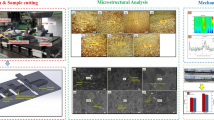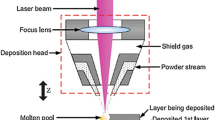Abstract
Ultrafine WC–Co–VC cemented carbides are used extensively in a variety of industrial environments due to their excellent mechanical properties and outstanding wear resistance. Co content affects the service performance of the cemented carbides. In the present study, the influences of Co content on microstructure, physical, and mechanical properties were investigated systematically. Ultrafine WC–Co–VC cemented carbides with Co content varying from 4 wt% and 7 wt% and assistance of VC (0.35 wt%) as inhibitor of WC grain growth were prepared. The physical and mechanical properties were tested and the microstructure characteristics were observed by optical microscope (OM) and scanning electron microscopy (SEM). From the results, it is found that with Co content increasing, both the cobalt magnetism and bending strength increase, while the coercive force, Rockwell hardness, density, and abrasive wear resistance decrease. In addition, the OM and SEM results show that the increase of Co content in WC–Co–VC cemented carbides tends to reduce the quantity and size of micro-pores, and make the fracture mode change from brittle fracture to ductile fracture.








Similar content being viewed by others
References
Lei CP, Tang JC, Cai DY, Wu AH. Microstructures and properties of WC–6Co cemented carbide prepared from high temperature reduction–carburization medium-size tungsten carbide powder. Chin J Rare Met. 2013;37(3):365.
Berger S, Porat R, Rosen R. Nanocrystalline materials: a study of WC-based hard metals. Prog Mater Sci. 1997;42(1–4):311.
Sun L, Yang TE, Jia CC, Xiong J. VC, Cr3C2 doped ultrafine WC–Co cemented carbides prepared by spark plasma sintering. Int J Refract Met Hard Mater. 2011;29(1):147.
Dai Z, Lin CG, Lin ZK. Influence of RE additives on microstructure of WC–8Co hardmetals produced from zinc-process reclaimed powder. Chin J Rare Met. 2013;37(3):359.
Guo GC. Liquid Phase Sintering of Powder Metallurgy Materials. Beijing: Chemical Industry Press; 2002. 47.
Hy Rong, Peng ZJ, Ren XY, Wang CB, Fu ZQ, Qi LH, Miao HZ. Microstructure and mechanical properties of ultrafine WC–Ni–VC–TaC–cBN cemented carbides fabricated by spark plasma sintering. Int J Refract Met Hard Mater. 2011;29(6):733.
Espinosa L, Bonache V, Salvador MD. Friction and wear behaviour of WC–Co–Cr3C2–VC cemented carbides obtained from nanocrystalline mixtures. Wear. 2011;272(1):62.
Xiao DH, He YH, Song M, Shen TT, Ou XQ. Microstructure and properties of ultrafine WC–10Co–VC–NbC cemented carbide. Trans Mater Heat Treat. 2010;31(10):26.
Sugiyama I, Mizumukai Y, Taniuchi T, Okada K, Shirase F, Tanase T, Ikuhara Y, Yamamoto T. Formation of (W, V)Cx layers at the WC/Co interfaces in the VC-doped WC–Co cemented carbide. Int J Refract Met Hard Mater. 2012;30:185.
Wang LL, Li HY, Liu N. Effects of Co content on microstructure and mechanical properties of cemented carbides. Rare Met Cem Carbides. 2011;39(1):66.
Sundin S, Haglund S. A comparison between magnetic properties and grain size for WC/Co hard materials containing additives of Cr and V. Int J Refract Met Hard Mater. 2000;18(6):297.
Liu SR. Coercive force of WC–Co cemented carbides. Cem Carbide. 2000;17(1):48.
Wu CH, Sun BQ. About saturation magnetization property of WC–Co cemented carbide—an indicator related to product quality control. Rare Met Cem Carbides. 1999;138(3):45.
Exner HE, Gurland J. A review of parameters influencing some mechanical properties of tungsten carbide–cobalt alloys. Powder Met. 1970;13(25):13.
Fang L, Gee MG, Roebuck B. Investigation of the abrasive wear behavior of WC/Co hard metals. Tribology. 2000;20(6):431.
Saito H, Iwabuchi A, Shimizu T. Effects of Co content and WC grain size on wear of WC cemented carbide. Wear. 2006;261(2):126.
Liu SR. Strength of WC–Co cemented carbide. Cem Carbide. 2002;19(3):129.
O’qugley DGF, Luyckx S, James MN. An empirical ranking of a wide range of WC–Co grades in terms of their abrasion resistance measured by the ASTM standard B611-85 test. Int J Refract Met Hard Mater. 1997;15(1–3):73.
Khruschov MM. Resistance of metals to wear by abrasion as related to hardness. In: Proceedings of the Conference on Lubrication and Wear, London; 1957. 655.
Hong J, Gurland J. A Study of the Fracture Process of WC–Co Alloys. In: Viswamadham RK, editor. Science of Hard Materials. New York: Plenum Press; 1983. 649.
Acknowledgments
This work was financially supported by the National Natural Science Foundation of China (No. 51074189).
Author information
Authors and Affiliations
Corresponding author
Rights and permissions
About this article
Cite this article
Shi, KH., Zhou, KC., Li, ZY. et al. Microstructure and properties of ultrafine WC–Co–VC cemented carbides with different Co contents. Rare Met. 41, 1955–1960 (2022). https://doi.org/10.1007/s12598-014-0424-y
Received:
Revised:
Accepted:
Published:
Issue Date:
DOI: https://doi.org/10.1007/s12598-014-0424-y




